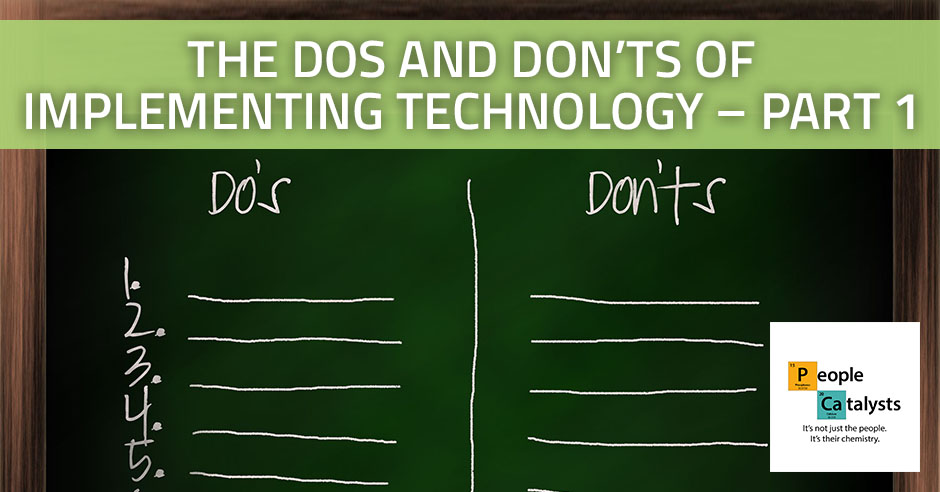The Dos And Dont’s Of Implementing Technology – Part 1

The ideation of adopting new technology is that 15% of the population will say yes to an idea right away, but after you’ve got it working, it’s time for implementing the technology and making iterations going forward. The early adopters are usually the ones who are open to using the new process and the late adopters are the ones who push back. The paradox is the more slowly you teach it, the faster it gets done. The most important thing is you don’t leave them alone with just a manual, and that you don’t quit because after all, it is a process. Discover methods to ensure, regardless if it’s your team or your client, that the technology you’ve developed is going to be used.
—
Listen to the podcast here:
The Dos And Dont’s Of Implementing Technology – Part 1
Welcome to the People Catalyst Podcast, Allen Fahden. How are you?
Life is beautiful. Even more beautiful now that we’re doing a podcast.
We had done a podcast in regard to technology. We had some questions arise from audience in that regard and we decided to develop a podcast that is not only about the ideation of new technology in creating it, but after you’ve got this thing working and it’s beautiful and then it’s time to use. After you make it and then from there you’re continuing to make iterations going forward. This reminds me of a story of a client that we worked with. We were in there for probably four hours times five or six trainings and they loved the sales and promote our pipeline that we were using for an example on a piece of the training.
They asked, “Who helped you develop that?” We referred them to the developer and the developer made the most beautiful sales pipeline and the most beautiful promoter pipeline for two of the different companies. Then they rolled them out, it looked beautiful and they didn’t use them. One of the pieces about this company is they have no early adopters except for just the CEO. We’ve got a lot accomplished, but the only way the process doesn’t work, that who do method, is if you don’t use it. They didn’t use it in regard to building out that sales in channel pipelines. That’s a huge issue.
It’s an interesting one because it’s one thing to create, it’s another one to get people to use it, to get it adopted. You think, “This is simple. We’ll go to the early adopters first.” That’s great. We’ve always talked about, “How are you going to find them?” There’s more to it than that. In a sense, when you’re trying to get something adopted, they’ve got you coming and they’ve got you going. What does that mean? You go to the early adopters because they want the new software and the late adopters are the ones that push back. They say, “It’s going to disrupt everything and we’re going to have to learn it and we don’t want that in there.” The early adopters eventually convinced by going through the process to use the software, to do the software. That’s great, so now everybody’s happy.

Implementing Technology: The more slowly you teach it, the faster it gets done.
Here’s another problem. It like a ping pong match. Now, it’s going the other way. Now, the late adopters are saying, “We can do that. I guess. We can live with that.” What do they do? They get an enrolled in it and they build out and the late adopters are good at learning how to use it, so they’ve got the whole thing down. Now, it comes time to go back the other way and to get the early adopters to use it, “Are you kidding me? What are you going to do? Make me read a manual or something? I don’t have time to do that. Shoot me now.” The early adopters don’t want it now, so you’ve got to use the same method and result. The whole message is, be vigilant here because it’s not an easy thing to do and a number of times, it doesn’t work.
It reminds me in the previous podcast that we did it and we touched on the ideation of adopting new technology. The mover is the 15% of the population that will say yes to an idea. I am an uber mover and I swear I know you need the technology. Please don’t ask me to use it. It’s just painstaking. Let’s talk about how you can use the WHO-DO Method in order to ensure, regardless if it’s your team, if it’s your client or if it’s your promoter is using the technology that you’ve developed.
Here’s one big clue. Slowly teach one step at a time. The paradox is the more slowly you teach it, the faster it gets done.
That’s absolutely true in my experience. That’s one of the reasons why when we work with new companies, we go in and we play games. It’s because number one, it makes it easier and it’s contextual, but we want them to take little bites of it at a time. If you go in and just do the training immediately and run to try to solve a problem, I did this because I was requested, begged by a nonprofit to do this once and I have to say, “Just follow my lead in.”
A lot of people get frustrated because they don’t understand what it is that you’re doing. You’re giving them the enchilada and you’re facilitating it. Yet they don’t have the piece. They learned that easier through playing a game because even if you play a game, when you have to solve a real problem, that’s when all the hairs standing up on the back of everyone’s necks. Yes, slowly teach one step at a time. Also, don’t leave them alone. You can’t just say, “Here you go, do it.”
Even more so, don’t make them read a manual. Somebody says they want a snack, don’t give them a buffet. I’m going to commit my life to learning something and then I’m not going to get my work done. Couldn’t you just make it a little bit easier?
Way back in the day, I was in finance. In finance, there’s always a lot of specifics. Even underwriting specific, everything. You had to sit in a classroom for five days and you had to figure out all the little blankety blanks that have to get filled in. It was painstaking. I get the training but what I did was I got an assistant. I’ve never put another number in any space in any computer sense. I’ve never once read a manual because, for me, the answer is go solve one thing at a time and I don’t even want to do it, but at least I can do it in that regard, most people can’t.
If you have a problem and you can identify that there’s one, two, three, four, just learn that piece. Most businesses from one segment only used about 20% of any software, so don’t make them read the manual. Then also slowly distribute the work over the team’s coordinator. I was talking about this with an assistant, so I learned it. I knew it was there but then pull in the other team’s core nature as applicable because it’s like a churning that will end up happening.
The great principle that comes to mind here is the Pareto, which is 20% of the work creates 80% of the results. Why give them 100% of something to learn? Instead, take it to 100% and divide it up over the core nature of each member of the team, especially the movers. The movers are going to say, “What can I do right now that’s going to make the most stuff happen? What’s the biggest priority?”
Don't quit. It's a process. It's designed to be perfect and it's just that nobody's learning the right thing at the right time. Share on XI want to let the audience remember, we’re talking about the later adopters. This technology is beautiful and now you’re engaging the early adopters to use the technology platform, whatever it is. Keep that in mind when you’re facilitating the WHO-DO Method that it’s this churning that’s going to happen and with each of the team’s core nature, they’re going to do a completely different part of the work but it’s fluid. It’s not something that you just, “We’re done with it, let’s go.”
This is something to pay attention to is don’t quit. It’s a process. What people do, they don’t say they’re quitting and you say, “How’s it going?” “It’s fine. I’m learning.” What does that mean? It usually means there’s a problem and people are settling. They’re settling for less. It’s designed to be perfect and it’s just that nobody’s learning the right thing at the right time.
Executives do this all the time is don’t make the report, the outcome update, whatever that thing that you developed the software for the most important part. Especially with the sales team. You see this over and over again and the managers want the reports. A lot of challenges come from that. It reminds me of a company we worked with.
Like the manager says, “I need to write the report right away because I want to ignore it more quickly.” We worked with a company whose sales manager has made it all about touching the customer so many times, 2,000 touches a month.
Not Referral, not facilitate relationships, but literally.
Make your number. What’s your number? Let’s see if we can annoy the customer’s 2,000 times this month by sending spam emails or whatever. The minute you start getting orders with the details, you start gaming the system. What happened is a lot of demotivated salespeople and performances and it’s a nightmare because that’s not what good salespeople do.
What was fun though about working with this particular company was after facilitating the process, we did a little bit of a pilot in one local city and this was not a big city. This was a publicly traded company. After working with them and working through the process, we were able to have a promoter strategy, which is basically work with an entity that has hundreds or thousands of your ideal client. Through doing this, somebody who hadn’t been with the company for very long in a city that is not a big city was like the number two salesperson in the company.
We increased the outcome by 43 times, something like that. They wanted to look at rolling it out across the whole US. They ended up slowly rolling it out but the specific individual ended up getting quite the promotion and. It was a process of over about eighteen months. One of the don’ts is don’t quit. It is a process. I would say that probably definitely with technology but with anything that you’re looking at accomplishing with the WHO-DO method, you don’t want to settle. You don’t want to say, “That’s enough.”
Because you’re always this close to results. When you said 43 times the results, I said amazing. On the other hand, it’s not amazing at all because in most companies, we work very hard to make sure people don’t perform well.

Implementing Technology: Leveraging the team’s core strengths and core nature of work, it just allows people to be better and faster at what they’re already fast at.
I love that you said that. It’s not magic, especially when you can have your team be three to eight times more effective using the WHO-DO Method. A lot of people think that, “That’s incredible.” It’s exactly the relay team I’m in. What are the numbers on that? I don’t have them off the tip of my head as far as a high school relay team.
The 400-meter relay world record is about 43.29 seconds and that’s one person running 400 meters. A mediocre relay team can beat that running the 400 in same distance. They can beat the world record holder in the individual sprint. They can beat that world record every time. That’s how powerful a relay team is.
Leveraging the team’s core strengths and core nature of work. It just allows people to be better and faster at what they’re already fast at instead of dumping a whole bunch of things on them that they’re absolutely slow at. As we’ve said before, failure doesn’t come from people even though you always hear the blame game. It comes from process, so failure is process failure, not people failure.
Deming said that the quality guy, 94% of failure is process failure.
This reminds me of a call I had of facilitating a call with the team and there’s the engineer on the phone, the marketer on the phone and the shaker-shaker-uber-shaker CEO on the phone. It’s interesting that to me, I was facilitating it. That’s why I was there as the mover and the shaker has done this over and again. They give the specs to the engineers 95% of engineers that have been assessed, our approvers. Then the shaker decides after we’ve already agreed upon everything, and he’s already done this a couple times and then we have to facilitate and go through the process. This time, the engineer had had it. The shaker that set new idea and the engineer blew up and was like, “You’re a late adopter. What you just did was very disruptive because of this and this.”
You run into a problem, all you do is press it. Don't give up and don't quit. Share on XEven though they know it, it’s so interesting that they’ll feel frustrated. They’ll point the finger, “You were supposed to do this,” and that’s exactly what the engineer was doing. Sometimes it comes out in blame. Sometimes it comes out in frustration. Sometimes it comes out in different ways. When you hit a brick wall, look at the situation, look at the core nature of everybody associated and many times you either stop and use the WHO-DO or even just explain what is happening here and then separate the two. I always like to say stay in your own lane or don’t commingle to animals and that’s critical when frustration happens because then that’s when and I would love. I can’t stand the word employee engagement. You’re just not asking them to do the part of the work that they like and so they’re not engaged. If there’s anything else you’d like to add to this conversation, Alan, now’s your time.
I’ll keep saying it again and again, don’t settle. Never quit. You run into a problem, all you do is press it and that’s the WHO-DO Method. Don’t depend on people to do it by themselves because to them, 150 years of work, it’s counter-intuitive. If you do use it, you’re going to keep the project moving and you’re going to get to where you want to go. Don’t give up and don’t quit.
Make sure you know your mover because you’re moving. We’ll keep it going. We’ll spend the time to learn the process and implement the process and keep everybody happy. Look for part two where we’re going to talk about this specific to sales. We’ll talk about it in regards to technology. We’re taking some time to talk about that and how you can utilize the same methodology within your sales team.
Links mentioned:
About Allen Fahden
 Author, corporate trainer, and former stand-up comic Allen Fahden has consulted with many Fortune 500 companies, as well as celebrity business owners Paul McCartney and Bill Murray. Allen was featured by People Magazine, ABC News, BBC TV, and countless television and radio broadcasts, as well as syndicated and local print media across the US
Author, corporate trainer, and former stand-up comic Allen Fahden has consulted with many Fortune 500 companies, as well as celebrity business owners Paul McCartney and Bill Murray. Allen was featured by People Magazine, ABC News, BBC TV, and countless television and radio broadcasts, as well as syndicated and local print media across the US
Creator of the 1 million selling Team Dimensions Profile, Allen wrote chapters for best-selling The One Minute Millionaire by Chicken Soup for the Soul co-author Mark Victor Hansen. He has also authored Innovation On Demand and Is Half the World Crazy?
Allen’s techniques resulted from years of developing ways to create new ideas that sell to both clients and the mass market. His experience in the field includes presiding over his own award-winning advertising agency, as well as serving as Senior Vice President and Creative Director of D’Arcy, Masius, Benton, and Bowles, and as Senior Writer for accounts such as Levi’s at Foote, Cone, and Belding in San Francisco.
Over 30 years working with teams as a corporate executive and as a trainer in Edwards Deming’s Quality processes, Allen pinpoints people’s strengths, allowing them to triple their performance in the beginning creating, planning and decision stages. By identifying what each team member does best, and not expecting them to do what they can not, he has transformed clients’ work,
Specialties: Speaking and training on Teams, Innovation and Creativity. Marketing specialist with an emphasis on branding.
